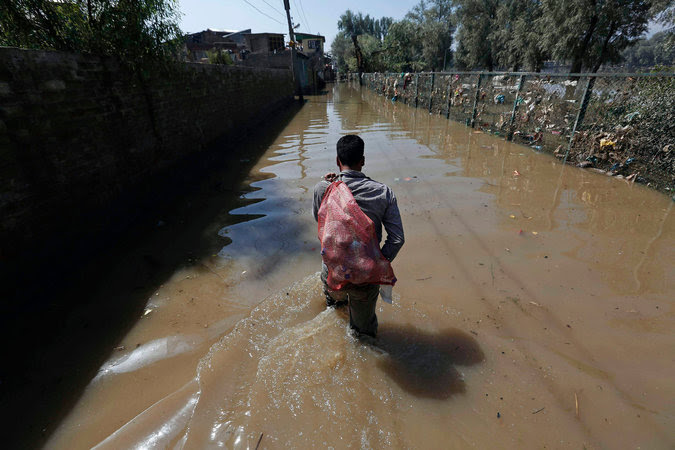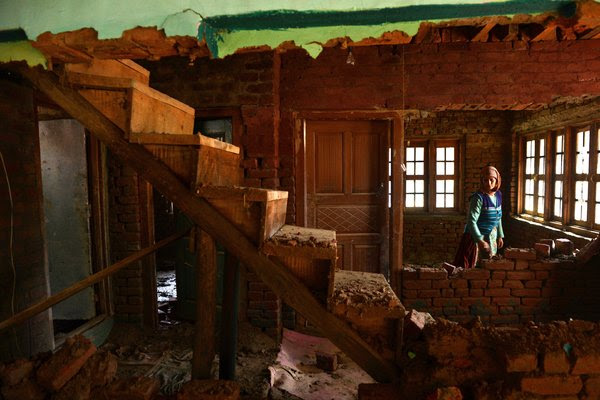NYT
By BETWA SHARMA and NIDA NAJARSEPT. 15, 2014

Srinagar residents are spurning Indian government aid as too little and too late, a week after floods devastated the area. Credit Adnan Abidi/Reuters
SRINAGAR, Kashmir — When an Indian military helicopter hovered low over a relief camp set up in a mosque in Kashmir’s capital on a recent afternoon, a crowd formed on the ground below, but it was not the grateful, grasping crowd one might expect amid a natural catastrophe.
The thudding rotors interrupted a speech after Friday Prayer by an aging leader of Kashmir’s separatists, Syed Ali Shah Geelani, who was criticizing the government for not coming to the aid of the flood victims quickly enough. The helicopter dropped sacks of food aid into a graveyard, but there were few takers. People threw them to the ground, pouring the grain inside onto the grass between headstones, and hurled bags over the fence onto the street below.
“We don’t want food from India,” some cried. Others asked where the relief had been for the past five days.
It has been a week since the Jhelum River breached its banks and inundated Srinagar’s labyrinthine old streets, driving tens of thousands of families from their homes, destroying maize and paddy crops, and clogging stagnant waters with the carcasses of dead animals.
Photo

A Kashmiri woman on Monday inside her house in Chak village, south of Srinagar, which had more rain on Sunday after flooding devastated the area last week. Credit Tauseef Mustafa/Agence France-Presse — Getty ImagesDeadly flooding occurs regularly across India, and rescue operations are often slow and scattershot. But Kashmir stands out for its bottled-up tension. Government relief has been difficult to come by. Commentators here have already begun to compare this disaster to Hurricane Katrina, for its devastation of a famously picturesque city and also for its emotional backdrop: It is unfolding in a place where, for historical reasons, trust between the populace and the central government is so low that some relief deliveries have dissolved into open confrontation.
For decades, India has maintained hundreds of thousands of security force members in Kashmir to fight an insurgency sponsored by Pakistan, which claims this border region. Though the insurgency is mainly vanquished, the Indian forces remain, occasionally facing stone-throwing revolts by young Kashmiri men who have grown up bristling under their gaze.
“There is obviously this huge accumulated experience with the army, which is, of course, anything but pleasant,” said Parvaiz Bukhari, a journalist in Srinagar who was trapped in his home for four days before he was rescued by other residents in a canoe.
He echoed the complaints of many of his neighbors, saying that the soldiers made it a priority to rescue the trapped families of the police and government officials, and avoided heavily Muslim neighborhoods.
“For many, it was like these people were rubbing salt on their wounds,” he said.
For the first week of the crisis, it was rare to find a police officer or a government official in the streets of Srinagar. Citizens organized themselves into relief crews, paddling homemade rafts or pleasure boats loaded with food and medicine. Today, water remains waist deep in some places, choked with empty bottles and plastic bags. Many remain in relief camps, wearing the grimy clothes they were wearing a week ago, but others have returned to half-drowned neighborhoods, preferring to rely on themselves rather than on the state.
Government rescue workers, for their part, described trying to operate a convoluted supply chain while facing a panicked, distrustful public. One soldier pointed at a broken window on his truck, which he said was caused by a crowd of stone-throwing men, and said his team was finally forced to abandon a boat and withdraw from the neighborhood. He said Kashmiri civilians might have mistaken his uniform — he was dressed in fatigues, with a padded vest, and carried a rifle — for full combat gear.
“It was a relief operation, not a tactical operation,” he said, a little sadly.
A National Disaster Response Force raft sat idle in one of the capital’s residential neighborhoods. Gambhir Singh Negi, the deputy commandant in charge, said that he had been waiting to unload a truck of 50,000 parcels of food and drinking water that the central government had sent to distribute, but it had been stopped by a crowd on the way from the airport. The truck never arrived. Mr. Negi gave a rueful smile. He said he had spent five days in the flood zone, waiting, but had not yet received a single shipment of aid from the government.
—
Leave a Reply